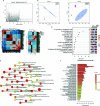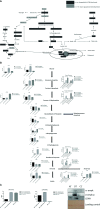Compound C, a Broad Kinase Inhibitor Alters Metabolic Fingerprinting of Extra Cellular Matrix Detached Cancer Cells
- PMID: 33718166
- PMCID: PMC7947618
- DOI: 10.3389/fonc.2021.612778
Compound C, a Broad Kinase Inhibitor Alters Metabolic Fingerprinting of Extra Cellular Matrix Detached Cancer Cells
Abstract
Most of the cancer related deaths are caused mainly by metastasis. Therefore, it is highly important to unfold the major mechanisms governing metastasis process in cancer. Throughout the metastatic cascade, cells need the ability to survive without attachment to neighboring cells and the original Extra Cellular Matrix (ECM). Recent reports showed that loss of ECM attachment shifts cancer cell metabolism towards glycolysis mostly through hypoxia. However, AMPK, a master metabolic regulator was also found to be upregulated under ECM detached conditions. Therefore, in this work we aimed to understand the consequences of targeting AMPK and other metabolic kinases by a broad kinase inhibitor namely Compound C in ECM detached cancer cells. Results showed that Compound C impacts glycolysis as evident by increased levels of pyruvate, but reduces its conversion to lactate thereby negatively regulating the Warburg effect. Simultaneously, Compound C induces block at multiple levels in TCA cycle as evident from accumulation of various TCA metabolites. Interestingly Compound C significantly reduces glutamine and reduced glutathione levels, suggesting loss of antioxidant potential of ECM detached cancer cells. Further, we found increased in metabolites associated with nucleotide synthesis, one carbon metabolism and PPP pathway during Compound C treatment of ECM detached cells. Finally, we also found induction in metabolites associated with DNA damage in ECM detached cancer cells during Compound C treatment, suggesting DNA damage regulatory role of metabolic kinases. Overall, our results showed that Compound C represses pyruvate to lactate conversion, reduces antioxidant potential and invokes DNA damage in ECM detached cancer cells. Our data provides a comprehensive metabolic map of ECM detached cancer cells that can be targeted with a broad kinase inhibitor, is Compound C. The data can be used for designing new combinational therapies to eradicate ECM detached cancer cells.
Keywords: AMP-activated protein kinase; compound C; extra cellular matrix detachment; metabolomic analysis; oxidative phosphorylation.
Copyright © 2021 Shait Mohammed, Alghamdi, Alzahrani, Zamzami, Choudhry and Khan.
Conflict of interest statement
The authors declare that the research was conducted in the absence of any commercial or financial relationships that could be construed as a potential conflict of interest.
Figures








Similar articles
-
Untargeted Metabolomics Showed Accumulation of One-Carbon Metabolites to Facilitate DNA Methylation during Extracellular Matrix Detachment of Cancer Cells.Metabolites. 2022 Mar 21;12(3):267. doi: 10.3390/metabo12030267. Metabolites. 2022. PMID: 35323710 Free PMC article.
-
Pyruvate uptake is increased in highly invasive ovarian cancer cells under anoikis conditions for anaplerosis, mitochondrial function, and migration.Am J Physiol Endocrinol Metab. 2012 Oct 15;303(8):E1036-52. doi: 10.1152/ajpendo.00151.2012. Epub 2012 Aug 14. Am J Physiol Endocrinol Metab. 2012. PMID: 22895781
-
Reprogramming of iron metabolism confers ferroptosis resistance in ECM-detached cells.iScience. 2023 May 9;26(6):106827. doi: 10.1016/j.isci.2023.106827. eCollection 2023 Jun 16. iScience. 2023. PMID: 37250802 Free PMC article.
-
Extracellular matrix regulation of metabolism and implications for tumorigenesis.Cold Spring Harb Symp Quant Biol. 2011;76:313-24. doi: 10.1101/sqb.2011.76.010967. Epub 2011 Nov 21. Cold Spring Harb Symp Quant Biol. 2011. PMID: 22105806 Review.
-
Recent advances in the role of AMP-activated protein kinase in metabolic reprogramming of metastatic cancer cells: targeting cellular bioenergetics and biosynthetic pathways for anti-tumor treatment.J Physiol Pharmacol. 2018 Jun;69(3). doi: 10.26402/jpp.2018.3.07. Epub 2018 Sep 28. J Physiol Pharmacol. 2018. PMID: 30279304 Review.
Cited by
-
Untargeted Metabolomics Showed Accumulation of One-Carbon Metabolites to Facilitate DNA Methylation during Extracellular Matrix Detachment of Cancer Cells.Metabolites. 2022 Mar 21;12(3):267. doi: 10.3390/metabo12030267. Metabolites. 2022. PMID: 35323710 Free PMC article.
-
Integrative metabolomics-genomics analysis identifies key networks in a stem cell-based model of schizophrenia.Mol Psychiatry. 2024 Oct;29(10):3128-3140. doi: 10.1038/s41380-024-02568-8. Epub 2024 Apr 29. Mol Psychiatry. 2024. PMID: 38684795 Free PMC article.
-
Venetoclax-Resistant MV4-11 Leukemic Cells Activate PI3K/AKT Pathway for Metabolic Reprogramming and Redox Adaptation for Survival.Antioxidants (Basel). 2022 Feb 25;11(3):461. doi: 10.3390/antiox11030461. Antioxidants (Basel). 2022. PMID: 35326111 Free PMC article.
-
Propranolol and Capecitabine Synergy on Inducing Ferroptosis in Human Colorectal Cancer Cells: Potential Implications in Cancer Therapy.Cancers (Basel). 2025 Apr 27;17(9):1470. doi: 10.3390/cancers17091470. Cancers (Basel). 2025. PMID: 40361395 Free PMC article.
-
Exploration of metabolic responses towards hypoxia mimetic DMOG in cancer cells by using untargeted metabolomics.Saudi J Biol Sci. 2022 Oct;29(10):103426. doi: 10.1016/j.sjbs.2022.103426. Epub 2022 Aug 22. Saudi J Biol Sci. 2022. PMID: 36091722 Free PMC article.
References
LinkOut - more resources
Full Text Sources
Other Literature Sources

